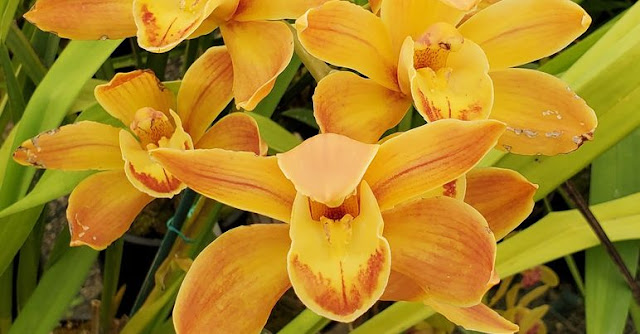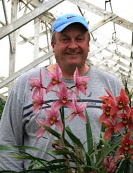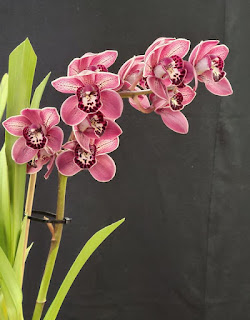
Sacramento society hosts evening with George Hatfield

|
| Cymbidiums need adequate light and water, says expert hybridizer George Hatfield. He will speak Friday evening in Sacramento. (Photos courtesy George Hatfield) |
Orchid royalty is coming to Sacramento!
On Friday evening, Dec. 3, Sacramento Valley Cymbidium Society presents an evening with Mr. Cymbidium, George Hatfield.
To be held at Shepard Garden and Arts Center, this free presentation will be held in person as well as offered via Zoom. Doors open at 6:30 p.m.; program starts at 7 p.m. The public is welcome.

|
|
George Hatfield
|
Based in Oxnard, Hatfield is past president of both the American Orchid Society and the Cymbidium Society of America. In an interview with Orchid Digest, Hatfield shared some of his insights including what he looks for in a plant as a hybridizer.
“Fundamentally, you need to have plants that grow well,” Hatfield told Orchid Digest. “It’s pretty meaningless to produce plants that can’t be grown by all levels of growers. No matter what type of plant you hybridize, it needs to be a good grower. I’ve been aggressively selecting for strong growers for years, and the result is that pretty much everything I produce can be grown by anyone.”
The most common mistake for cymbidium growers? Water, Hatfield said.

|
|
Cymbidiums produce loads of flowers
with the right care.
|
“Cymbidiums need light,” he added. “Most people don’t grow their plants in enough light. The three biggest elements of good culture are light, water, and nutrients. Pay attention to those, and a good cymbidium will reward you with lots of flowers.”
Learn more Friday night at his special presentation. Shepard Center is located at 3330 McKinley Blvd., Sacramento, in McKinley Park.
For more details or Zoom link, email SacCymSoc@yahoo.com or call Ann Carberry at 916-502-3258.
Comments
0 comments have been posted.Sacramento Digs Gardening to your inbox.
Sites We Like
Garden Checklist for week of May 5
Survey your garden after the May 4 rainstorm. Heavy rain and gusty winds can break the neck of large flowers such as roses. Also:
* Keep an eye on new transplants or seedlings; they could take a pounding from the rain.
* Watch out for powdery mildew. Warmth following moist conditions can cause this fungal disease to “bloom,” too. If you see a leaf that looks like it’s dusted with powdered sugar, snip it off.
* After the storm, start setting out tomato transplants, but wait on the peppers and eggplants (they want warmer nights). Pinch off any flowers on new transplants to make them concentrate on establishing roots instead of setting premature fruit.
* Trim dead flowers but not leaves from spring-flowering bulbs such as daffodils and tulips. Those leaves gather energy to create next year's flowers. Also, give the bulbs a fertilizer boost after bloom.
* Pinch chrysanthemums back to 12 inches for fall flowers. Cut old stems to the ground.
* Mulch around plants to conserve moisture and control weeds.
* From seed, plant beans, beets, cantaloupes, carrots, corn, cucumbers, melons, pumpkins, radishes and squash.
* Plant onion sets.
* In the flower garden, plant seeds for asters, cosmos, celosia, marigolds, salvia, sunflowers and zinnias. Transplant petunias, zinnias, geraniums and other summer bloomers.
* Plant perennials and dahlia tubers for summer bloom.
* Don’t wait; plant summer bulbs, such as gladiolus and tuberous begonias.
* Harvest cabbage, lettuce, peas and green onions.